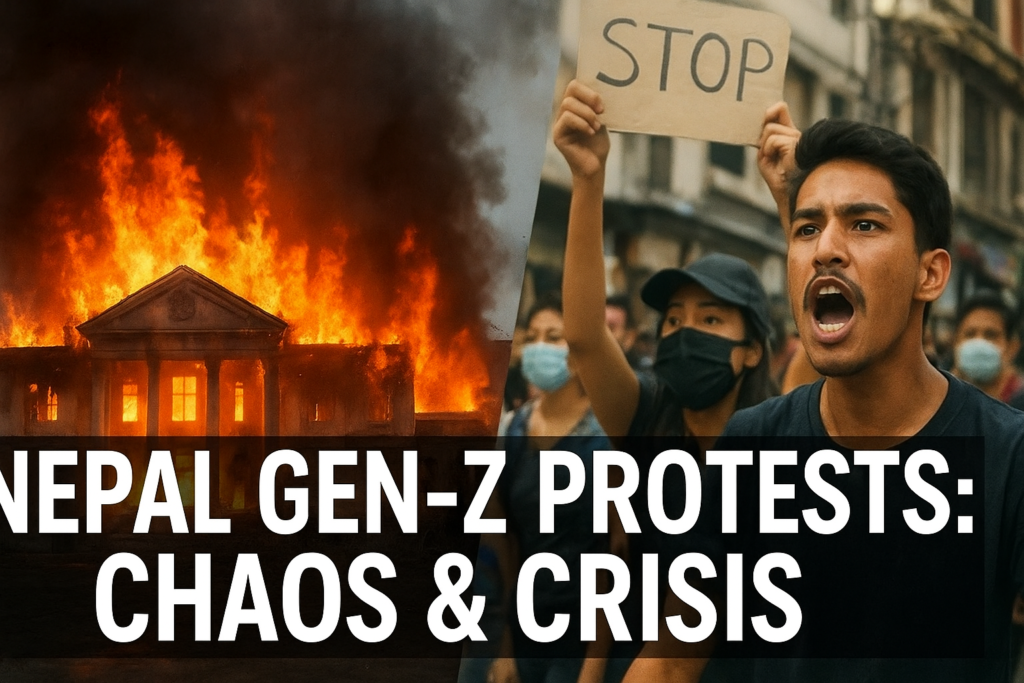Nepal erupts as Gen-Z protests turn violent. Ex-PM Deuba attacked, Khanal’s wife killed, parliament torched. A nation faces its biggest crisis yet.
Nepal’s Gen-Z Uprising: Chaos, Flames, and a Cry for Change
Introduction: When Silence Was No Longer an Option
Nepal, a country known for its majestic Himalayas, rich history, and peaceful traditions, has been engulfed by a fire of wrath. What started the firestorm? A government plan to outlaw social media, rather than stifling criticism, sparked outrage among the country’s youth.
This generation, already burdened by unemployment, economic misery, and political corruption, saw the ban as the final blow. In an instant, streets became battlegrounds, political figures became targets, and Kathmandu, Nepal’s once-calm city, descended into mayhem.
Brutality Unleashed on Political Leaders
Deuba and His Wife Beaten in Public
Among the most disturbing images to emerge were those of Sher Bahadur Deuba, Nepal’s five-time Prime Minister, and his wife, Arzu Rana Deuba, who also serves as Foreign Minister. Videos showed them being dragged, punched, and left bleeding. For many, this was not just an attack on individuals but a symbolic tearing down of the political elite.
Khanal’s Wife Burnt Alive

The violence escalated when protesters set fire to the home of former Prime Minister Jhala Nath Khanal. Rajyalaxmi Chitrakar, his wife, was tragically burned alive after failing to flee the fire. Her killing rocked the nation’s conscience, demonstrating that the movement, which began in despair, had devolved into horrific brutality.
Kathmandu is Under Siege
Parliament and Supreme Court in Ashes
The flames did not stop at private homes. Protesters assaulted government buildings, setting fire to the parliament building, the Supreme Court, and parts of Nepal’s historic administrative hub, Singha Durbar. These were not merely buildings, but symbols of power. And the fire conveyed a message: the people no longer trust their leaders.
Streets Drenched in Blood and Smoke
The streets of Kathmandu echoed with gunshots and shouts. At least 19 individuals were killed, with many more injured. Protesters and security personnel engaged in running clashes. Jails were broken into, inmates escaped, and businesses were closed as regular folks fled in terror. For days, the capital resembled a war zone more than a city.
Government in Meltdown
Oli Resigns Amid Unrest
Amid the growing anarchy, Prime Minister K.P. Sharma Oli stepped down. His resignation was less a demonstration of accountability than a panicked escape under army cover. The resignation, however, did little to quell the wrath of protestors, who wanted not only new leadership but fundamental transformation.
Curfews, Troops, and Airports Shut Down
Authorities scrambled to regain control. Nationwide curfews were declared, troops were deployed, and flights were halted. Even Kathmandu’s international airport was shut down as thick smoke filled the skies, leaving passengers stranded. Despite the clampdown, anger grew hotter.
The Heart of the Uprising: Gen-Z’s Fury
No Future, No Hope
Nepal’s Gen-Z is a generation without patience for excuses. With unemployment soaring above 20 percent, thousands of young Nepalis leave the country every year to work abroad. Those who stay behind see little hope in a political system plagued by nepotism, corruption, and favoritism.
The “Nepo-Kid” Resentment
Much of the anger has been directed at the privileged children of political elites—popularly dubbed “nepo-kids.” Young Nepalis accuse them of flaunting luxury lifestyles funded by corruption, while ordinary graduates struggle to find even modest jobs. This resentment, simmering for years, erupted the moment social media was taken away.
The Social Media Ban Backfires
Ironically, the attempt to silence dissent by banning social media backfired spectacularly. For Gen-Z, whose lives are deeply intertwined with digital spaces, the ban was not just about connectivity—it was about identity, freedom, and the right to be heard. Instead of muting them, it amplified their fury.
Army Intervention and Presidential Pleas
Army Steps In
The Nepal Army, led by Commander Ashok Raj Sigdel, moved swiftly into the streets. Tanks rolled in, soldiers patrolled, and checkpoints sprouted across Kathmandu. Their presence brought a measure of control but also heightened tensions, as many saw the army as protectors of the very political class they opposed.
President’s Appeal Amid Flames
President Ram Chandra Poudel attempted to appeal for peace. Yet even his own residence was not safe from attack. Standing before a nation in turmoil, he urged dialogue over destruction. But words alone felt powerless in the face of so much bloodshed and fire.
A Nation at a Crossroads
What is unfolding in Nepal is more than a protest—it is a generational reckoning. For Gen-Z, this is not just about a ban on social media. It is about decades of frustration boiling over: the corruption that never ends, the privileges they will never access, and the future they fear will never arrive.
The uprising raises pressing questions. Can Nepal’s political leaders finally acknowledge the voices of the young? Or will the state respond with only force, deepening the divide between rulers and the ruled?
One thing is certain: Nepal will not return to “normal” anytime soon. The flames that consumed buildings in Kathmandu have also burned away illusions. Gen-Z has declared, loudly and violently, that their silence is over.
